Following the Guangzhou Auto Show, the Volkswagen Group organized a domestic communication session with their German senior executives, aspiring to rank amongst the top three in the Chinese electric car market. In the past gasoline market, models like the Magotan and the Passat were the linchpins of Volkswagen’s sales, but now they’re pinning their hopes on the ID.7.

On November 22, 2023, the Volkswagen ID.7 debuted. The Volkswagen ID.7 VIZZION officially started pre-sales with the guide price of the debut version set at 2.3777 million yuan. After reviewing its config, the 2.3777 million yuan correspond to the top configuration of the two-wheel-drive variant; in other words, The Volkswagen ID.7 VIZZION is targeting the currently most competitive 200,000-250,000 yuan pure electric B-class car market.

Being an owner of a genuine ID car over a duration of 1 and a half years, I sincerely anticipate the design, control, and space utilization of the ID.7 VIZZION. However, I question its intelligence and electrics.
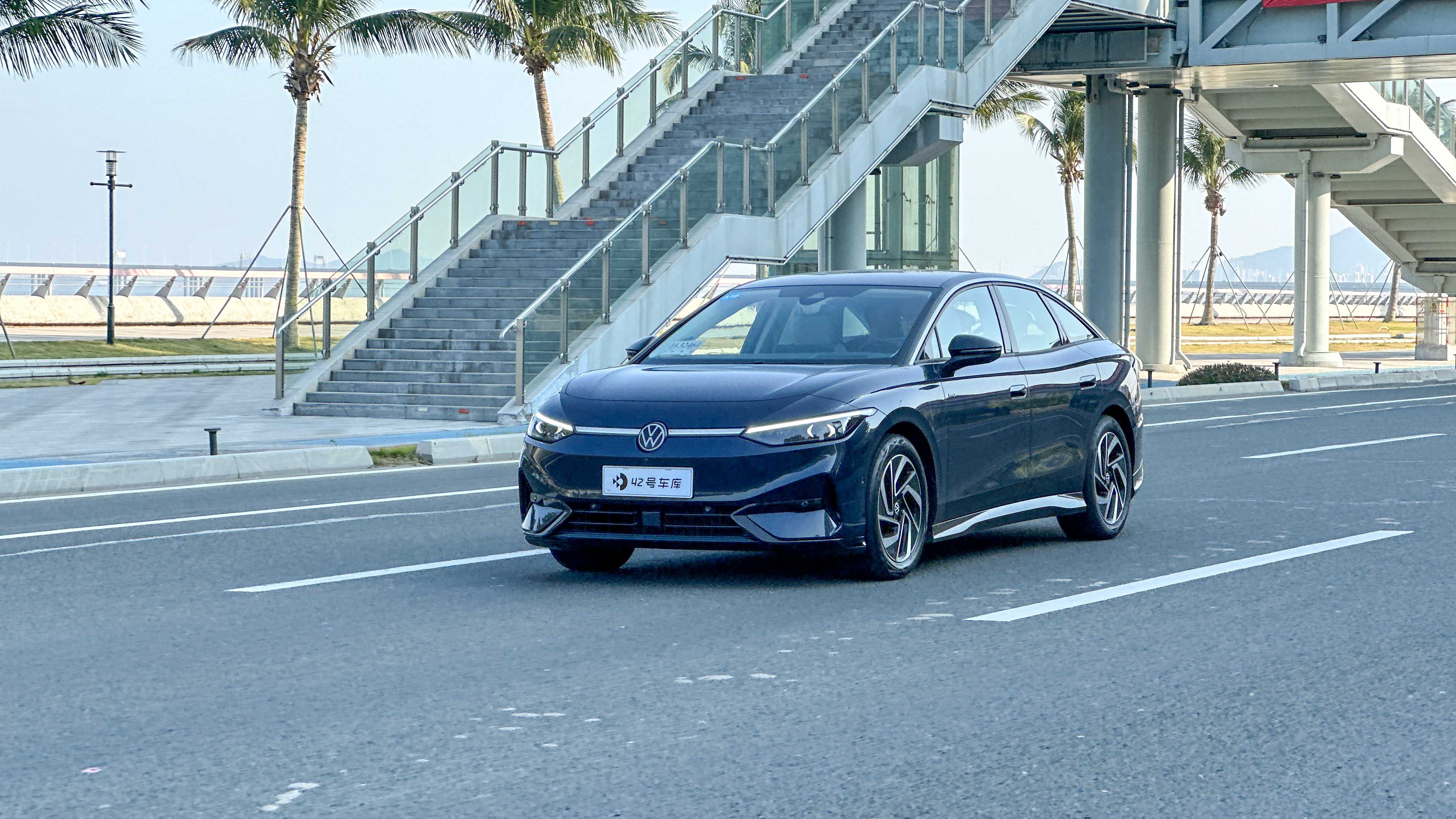
This is because, at this price range, consumers are more interested in family-friendly characteristics such as practicality, intelligence, and robust range. We have had a static experience in April. For those interested, you can revisit the article: 「」. Then, this test drive will focus on the handling, energy consumption, assisted driving and car system to evaluate the competitiveness of the ID.7 VIZZION in the 200,000-250,000 yuan pure electric midsize car market.
With the same MEB chassis, why is the ID.7 considered a flagship?
Driving Impressions
Before the ID.7 started its trial run domestically, it had already been driven overseas. I’ve read many overseas media test drives, of which, the highest praises compared the vehicle’s handling to that of a Benz EQE. After all, in terms of chassis hardware, the front McPherson and rear five-link independent suspension of the ID.7 VIZZION, in mechanical terms, seem to lack compared to the EQE’s double wishbones.

Volkswagen ID.7 VIZZION remains built on the MEB platform, whose suspension system is consistently similar to that of ID.3/4/6. Hence, before the test drives, it seemed to me that ID.7 wouldn’t differ much from the other models, given their similar performance.

Upon exploring the ID.7 VIZZION, the mechanical integrity delivered by the MEB platform seemed to be elevated by Volkswagen engineers. The driving sensation of Volkswagen ID.7 VIZZION equals the caliber of a quality-assuring German midsize sedan.
The first impression was that the steering was fairly heavy. Even in comfort mode, the steering torque required is heavier than what competing models demand. This characteristic brings joy to performance car enthusiasts and those who prefer a stable steering feel.

The more weighty steering offers the perk of a more assured control sense during high-speed and intense driving. However, it might be slightly daunting for most female users in low-speed parking situations. The ID.7 VIZZION’s steering precision outperforms that of ID.4/6 and parallels that of smaller cars like the ID.3. The adjunction strikes a balance, avoiding over sensitivity or delayed response. It yields a pleasant driving experience in daily operation.

It is worthy to mention the stellar steering design of the ID.7 VIZZION, which follows the good traditions of the MEB platform with an exaggerated front wheel turning angle. Although there is no rear-wheel turning due to cost concerns, enhanced steering angle offers impressive flexibility. Its turning radius during U-turns approximates the 4.2 m of the Golf, which could alleviate my “big car resistance” when needing to frequently move cars in residential areas.

In terms of power, ID.7 VIZZION uses the same APP310 engine as ID.3/4/6, with a maximum power of 150 kW and maximum torque of 310 N•m. Undoubtedly, it’s a powerhouse. Fortunately, it’s Volkswagen’s tuning that still subjectively delivers decently sufficient power performance.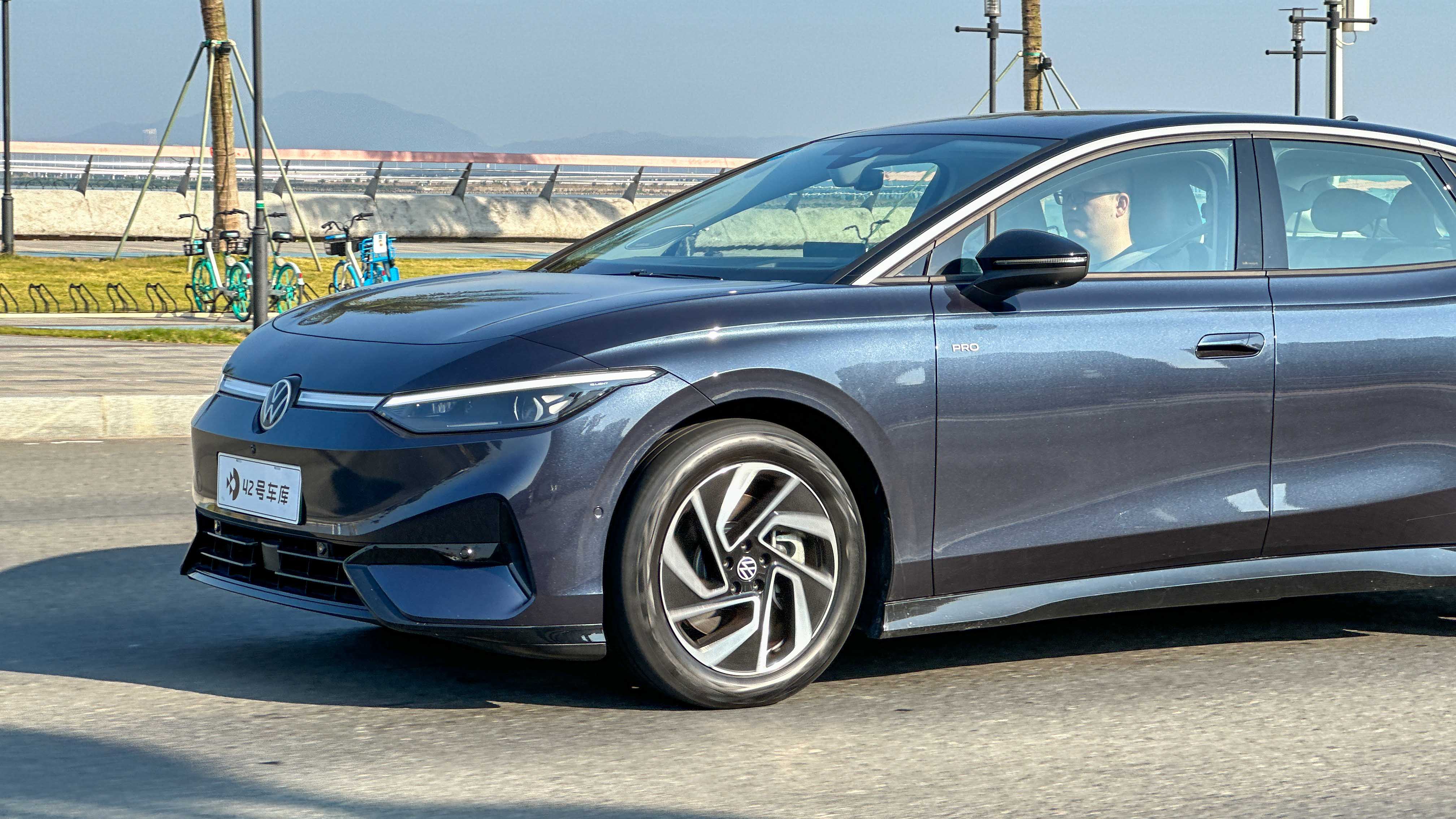
The accelerator pedal of the ID.7 VIZZION is quite weighty and has substantial travel, coupled with its tuning, yields an excellent linear response – you get what you give, essentially. Given the motor’s initial power output, it still provides impressive early to mid-range acceleration in the city and on flyovers, although the later stage acceleration is considerably softer. For enthusiasts seeking more power, you can opt for the dual-motor all-wheel drive, which is the powertrain found in the overseas GTX.

In international markets, both the single-motor ID.7 VIZZION and the 24 versions of the ID.4/5 have been outfitted with the latest APP550 motor which features a peak output of 210 kW and maximum torque of 550 N•m, perfectly aligning with the current mainstream standards for domestic pure-electric cars. Thus, we eagerly anticipate the rapid production and application of this motor in domestically-produced pure-electric vehicle models by the Volkswagen Tianjin Transmission Ltd.

Finally, let’s talk about the suspension tuning of the ID.7 VIZZION. After roughly 100 km of driving, this suspension system exhibited a sterling balance over a variety of road condition, truly reflecting Germanic finesse.

Initially, the tune of this suspension is towards the firm side. If you are acquainted with the ID.4/6 or the BYD Han EV, you’ll find the ID.7 VIZZION distinctly stiffer. The firmness is evident in the car’s nimble and unambiguous management of bumps and potholes on the road. In scenarios such as flyovers, the suspension’s compression rebound action is crisp and controlled, minimizing body roll. Its firmness also translates into clear road feedback – you can tell the difference with a change in road surface or even the timing it was laid. The suspension is resolutely sporty and ensures a stable, quick ride.
Ride Comfort
While you may assume that this vehicle’s ride comfort might be less than optimal given its firm suspension, here is where Volkswagen’s tuning expertise shines. The basic suspension composed of MacPherson struts and a multi-link; even in the absence of any CDC system in the top-spec, two-wheel-drive model I tested, despite a clear road feel and firm suspension, actual vibrations or impacts transferred onto the seats are notably minimal.
Whether I’m sitting in the front or the back, I can feel the stiffness of the chassis. The majority of my judgment is based on the suspension’s NVH and the subtle motion beneath the spring. The ride smoothness from an actual sit-in is quite impressive, invoking feelings akin to riding in the premium mid-large cars from luxury brands such as Benz, BMW, and Audi – a notch above same-class vehicles like Passat and Magotan. Part of this is credited to the tuning from the veteran automaker, and partly it’s due to ID.7’s extraordinary torque rigidity of over 46,100 N.m/deg.

During the ride, the NVH of the ID.7 VIZZION pleasantly surprised me. Already in the static experience back in April, I got a sense of a serene isolation upon closing the door. The running on-road experience was no different. Sadly, I didn’t bring a decibel meter for this test. I used an Apple Watch for a preliminary test, take it as reference and we’ll do a thorough test with proper gears once we have the car.
On the same stretch of road, the internal noise at 70 kph is 56 dB, 61 dB at 100 kph and only 64 dB at 120 kph. From a subjective perspective, there was no distinguishable, shrill wind noise when running at high speed, and the Michelin EC6 tires did a good job of suppressing tire noise. Based on my personal music listening habits, with the ID.7 traveling at a speed of 120 kph, if the music volume exceeds 5 bars (approx 15%), it feels a bit loud, which further shows the NVH is fairly top-notch.
Another impressive part of the ride experience is the seating posture and long-term comfort.

The seating position of the ID.7 VIZZION can be considered quite low among the same class of electric vehicles. When I adjusted the front seat to the lowest and to my comfortable seating position, my legs were almost as straight as they would be in a fuel sedan. At that time, the headroom allowed for a vertical palm distance (my height is 175 cm). Meaning someone as tall as 185 or even 190 cm could comfortably drive this vehicle.
 The rear seating is equally commendable. Thanks to the vehicle’s height of 1,537 mm, the height of the seat cushion is well controlled, eliminating the feeling of sitting on a bench. Moreover, the rear passengers can naturally stretch their feet under the front seats. Another feature is that the ID.7 VIZZION doesn’t utilize a moonroof to ‘steal space’; hence in summer, your head won’t be exposed to intense sun. Even after removing the sunshade curtain, the light-sensing moonroof can ensure that the car interior is not exposed to intense sunlight while still having ample light.
The rear seating is equally commendable. Thanks to the vehicle’s height of 1,537 mm, the height of the seat cushion is well controlled, eliminating the feeling of sitting on a bench. Moreover, the rear passengers can naturally stretch their feet under the front seats. Another feature is that the ID.7 VIZZION doesn’t utilize a moonroof to ‘steal space’; hence in summer, your head won’t be exposed to intense sun. Even after removing the sunshade curtain, the light-sensing moonroof can ensure that the car interior is not exposed to intense sunlight while still having ample light.


The ID.7 VIZZION’s wheelbase of 2,965 mm provides me, at a height of 175 cm, with a legroom of 1 fist + 1 palm when seated in the second row. It’s no exaggeration to say this space is almost catching up with the standards of mid-to-large-sized sedans.

Therefore, the overall driving and riding experience of ID.7 VIZZION is very premium, and it is among the few recommended models in the 200,000-250,000 range. The ID.7 VIZZION is a vehicle that is comfortable for the driver to drive and delivers a luxurious feel to the passengers. If you are not so keen on intense power output, the tuning and dynamic performance of the Volkswagen ID.7 VIZZION can satisfy everyone’s most valued needs for household quality.
A Range of 500 km is the Limit
During dynamic driving, we also deliberately observed the energy consumption and endurance performance of the ID.7 VIZZION. The model uses an 84.8 kWh ternary lithium battery, and the official CLTC range is 642 km.

On the test-driving day, the temperature was around 25°C, slightly hot, so we switched on the A/C with a temperature setting of 22°C and 2-level wind, and the car was in a half-load condition. For the first 50-plus km of elevated roads, the energy consumption was only 14.5 kWh/100 km. The 0.23 drag coefficient provided a good basis for energy consumption under steady-state driving.
 Half of the 50 km was spent on the highway, while the other half was spent on stop-and-go urban roads, thus resulting in an energy consumption of 16 kWh/100 km.
Half of the 50 km was spent on the highway, while the other half was spent on stop-and-go urban roads, thus resulting in an energy consumption of 16 kWh/100 km.

Throughout the testing process, we didn’t intentionally preserve our range. Rather, we attempted to simulate common vehicle use situations as much as possible. Consequently, based on power consumption estimates, the ID.7 VIZZION single motor model could achieve a real-world range of approximately 500 km under the current temperature conditions.
Volkswagen’s Lane Change Instructions
Finally, the ID.7 VIZZION presents new features in assisted driving. The hardware parameters remain consistent with the existing ID series, with the front-facing camera being the Mobileye EyeQ4 plus a 3 mm wave system. The software version has been upgraded to Travel Assist 3.0, introducing the command lane change function on top of the basics of TA 2.0.
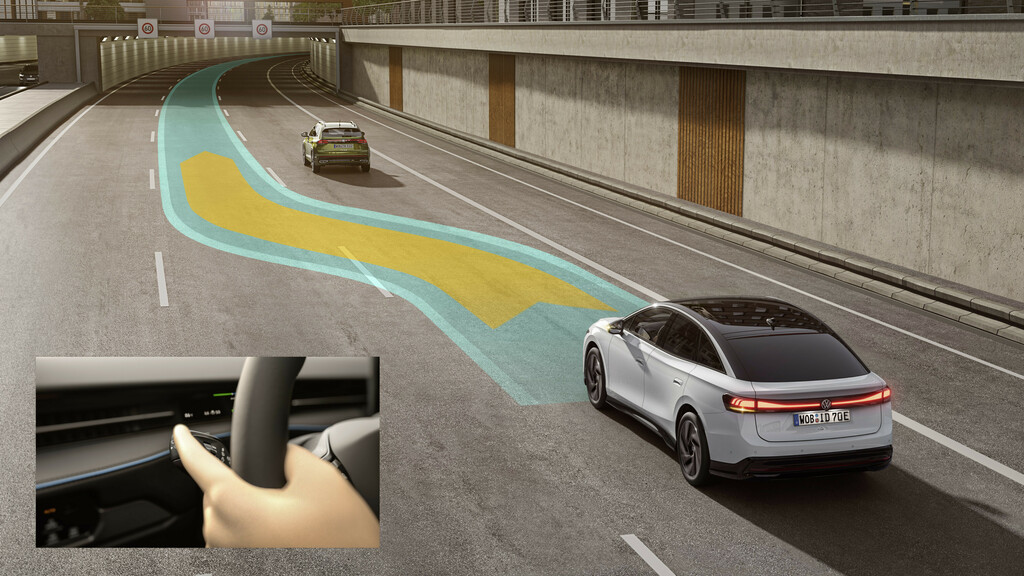
The condition to trigger this system’s lever lane change is a speed exceeding 72kph. Once activated, maintaining a minimum speed of 64 km/h will ensure execution, given the system verifies a safe environment for changing lanes. My experience on the elevated highway was satisfactory concerning both change-lane efficiency and comfort control.
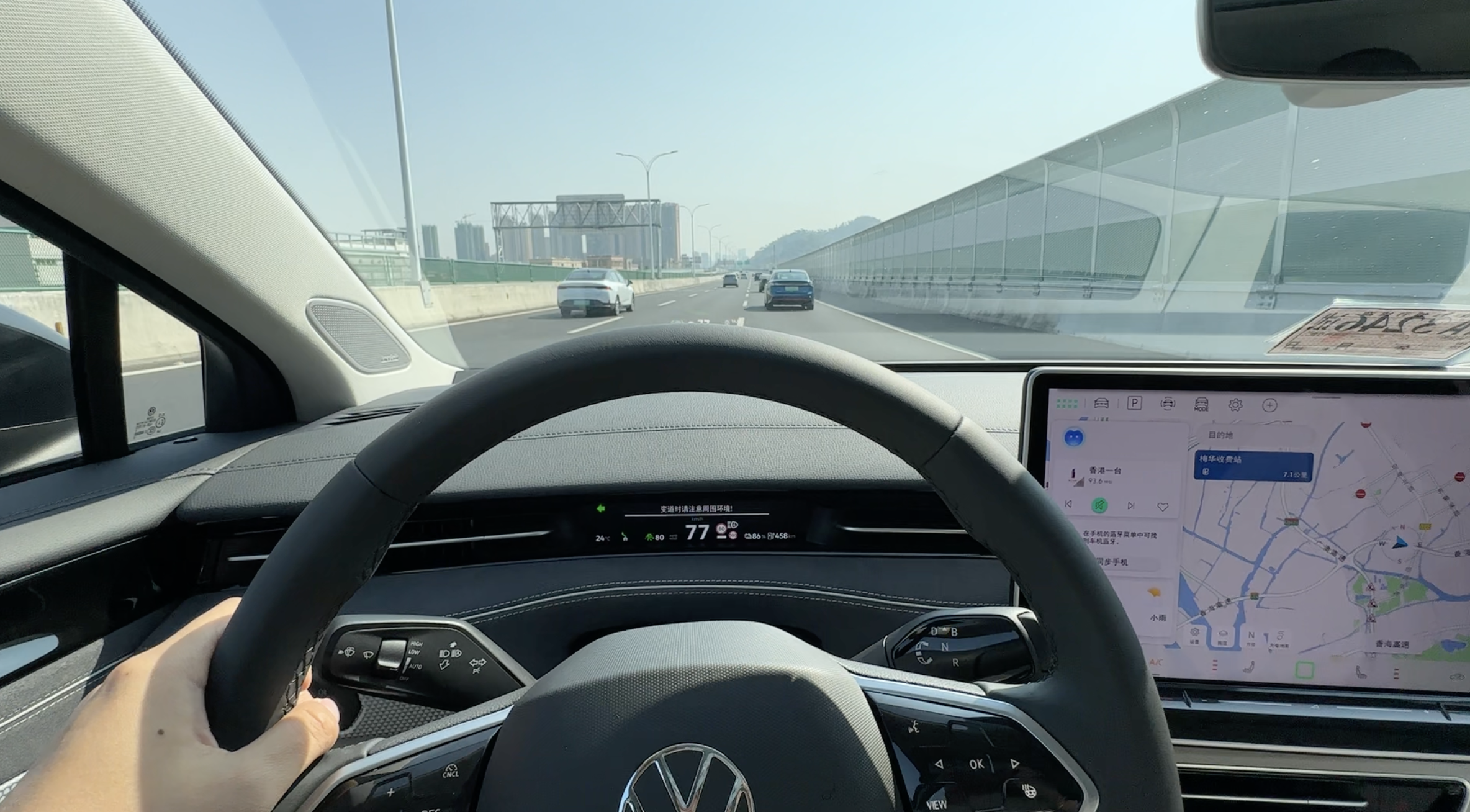
During interaction, activation is only possible with a light touch of the turn signal. This way, it’s not necessary to manually reset the turn signal after completing the lane change. During the lane change, drivers must hold the capacitive steering wheel, and the AR-HUD will display the progress of the lane change process in real-time. Overall, the interaction logic is flawless.
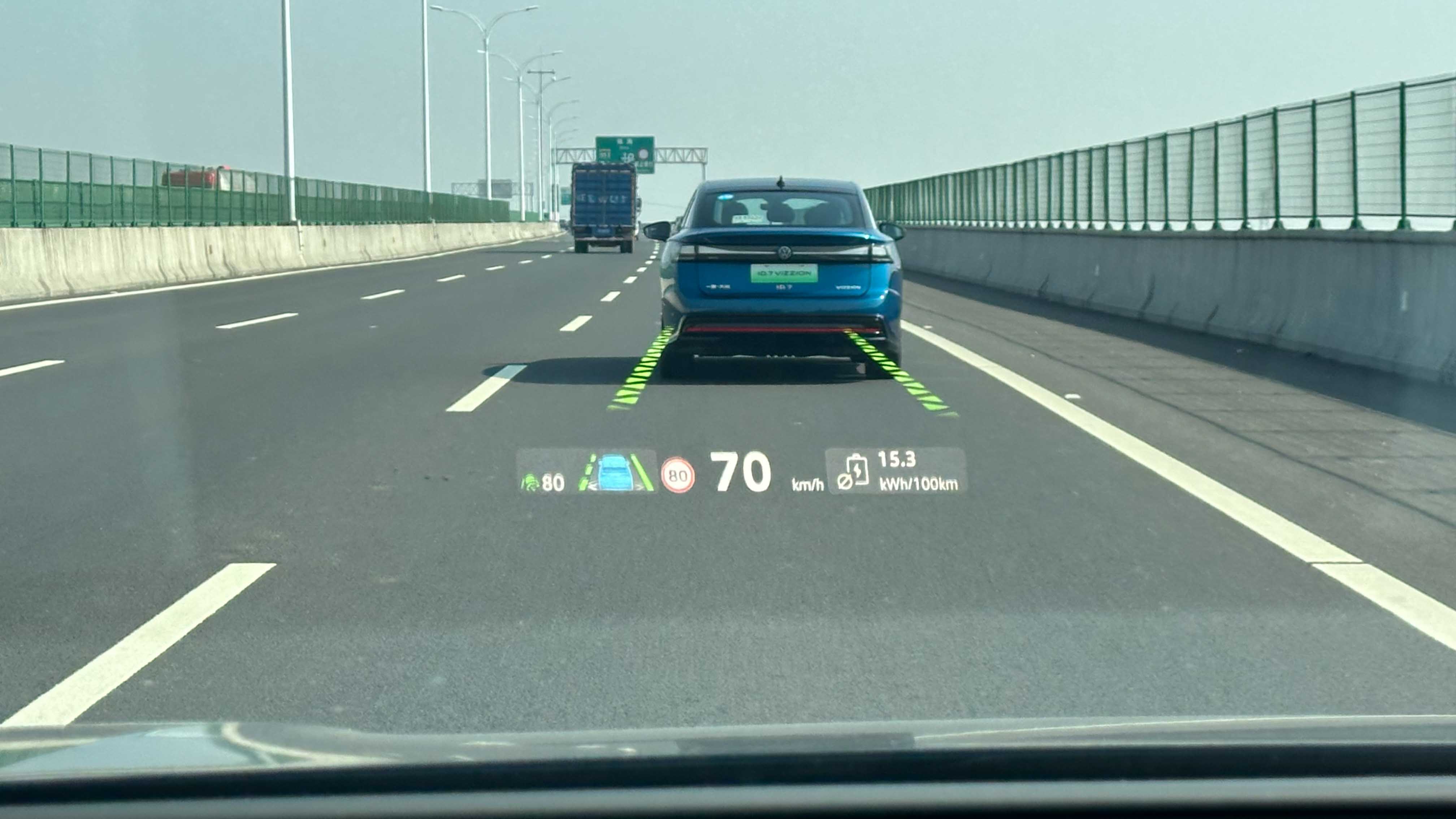
With Volkswagen incorporating instructions for lane changes, it has finally caught up with BMW and Benz at the basic assisted driving level. However, to contend with numerous high-level assisted driving systems within the domestic market, traditional German car manufacturers still have a lengthy road ahead. Volkswagen’s wholly-owned subsidiary, CARIAD, responsible for software development, is in deep cooperation with Horizon for high-level assisted driving solutions. In this age of intelligence, the earlier Volkswagen can implement a higher level of smart driving solutions, the more secure its position among joint-venture brands.
Finally Catching Up with Intelligence
However, this time, the ID.7 VIZZION has finally made up for its shortcomings in in-car intelligence. In terms of interior design, the ID.7 VIZZION remains consistent with the ID family language, which is very user-friendly for ID owners like myself. However, as the flagship of the ID series, considerable improvements have been made with reference to the ID.3/4/6, especially regarding in-car systems, ambience, craftsmanship, materials and more, and these enhancements will lay the foundation for Volkswagen’s domestic design in the years to come.
Let’s start with the technology details, which is the in-car interaction everyone cares about. Volkswagen has used a brand new in-car system on the ID.7 VIZZION, first and foremost, the central control screen has been updated to 15 inches, the resolution has reached 2,240 × 1,260, with a memory of 16 GB, at the same time the in-fotainment system has been updated to ID. OS 2.0.

The version of the in-car system is 4343, a significant leap when comparing with the current-sales of 29XX versions on ID.3/4/6. The underlying development has switched from being driven by Germany to Chinese teams.

In terms of use, first the fluidity has been greatly improved over the current model, especially in the touch control, it can be said to be one of the most convenient models I’ve ever experienced in joint venture brands. The feedback after clicking is also reasonable, except for the frame rate being a little lacking.

In fact, the interface has greatly improved compared to the current ID series. The cards on the left and the quick settings on the top can be customised, with a plenty of options. The display effects, both in day and night modes, are quite satisfactory, and the components are also placed reasonably. Currently, the third-party applications in the app store are not plentiful, the NetEase Cloud music and B-site in the current model’s version are not yet registered, and need to wait for adaptation.

Worth mentioning is the ‘Hello Volkswagen’ voice assistant on the ID.7 VIZZION presents an intelligent update. One is that Volkswagen’s voice assistant finally gets a virtual avatar, named ID Mate, where you can customise the image of the voice assistant, and the voice system has also been updated to the latest version of iFlytek. The other is the voice of the voice assistant, which no longer sounds so mechanical, can already inject some emotions, now it finally has some connection with intelligence in the subjective experience.

Although we can see, overall, the in-car system on the ID.7 VIZZION cannot outperform the new forces, but from the experience of the test drive, Volkswagen’s decision to shift the in-car system’s development rights from Germany to China is entirely correct. This is also as a current ID owner, where I felt the most difference when looking at the in-car system of the ID.7 VIZZION.
The latest total of 24 overseas models of ID.4, as well as the all-new Tiguan and Passat, have now been released. The infotainment systems used in these new Volkswagen cars are all the same as that found in the ID.7 VIZZION, including the upcoming 8.5 generation of Golf. Therefore, the ID.7 VIZZION’s infotainment system sets the intelligence level for all-electric and fuel-powered Volkswagens in the coming years.
In Conclusion
The launch edition of the FAW-Volkswagen ID.7 VIZZION, with a guide price of 237,770 yuan, has already established its core competency in the 200,000-250,000 yuan market segment. In terms of quality, space, and practicality, it can hold its own among its peers at this level.
For the Volkswagen brand, the pricing of the ID.7 has also seen much effort. Having undergone the price adjustments of the ID.3/4/6, and managing to price the rear-drive high-configuration version at 240,000 yuan, whilst breaking their own pricing structure and undercutting the guide prices of the similarly configured Magotan and Passat, it exemplifies the audacity of Volkswagen. Moving forward, we may expect even more surprises from the official market prices of the each version of FAW-Volkswagen ID.7 VIZZION.
This article is a translation by AI of a Chinese report from 42HOW. If you have any questions about it, please email bd@42how.com.
